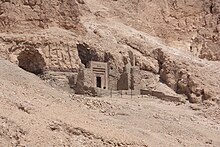





A hypogeum or hypogaeum (plural hypogea or hypogaea, pronounced /haɪpɒɡeɪə/; literally meaning "underground", from Greek hypo (under) and ghê (earth)[1]) is an underground temple or tomb.
Hypogea will often contain niches for cremated human remains or loculi for buried remains. Occasionally tombs of this type are referred to as built tombs.[2]
The term hypogeum can also refer to any antique building or part of building built below ground such as the series of tunnels under the Colosseum which held slaves (particularly enemy captives) and animals while keeping them ready to fight in the gladiatorial games. The animals and slaves could be let up through trapdoors under the sand-covered arena at any time during a fight.
- ^ James Stevens Curl (2006) A Dictionary of Architecture and Landscape Architecture
- ^ Hadjisavvas, Sophocles (2013). The Phoenician Period Necropolis of Kition, Volume II. Shelby White and Leon Levy Program for Archaeological Publications. p. Preface.
two important built tombs, namely the Ikarou Street Tomb and the Lefkaritis Tomb were the primary reasons for the authoring of The Phoenician Period Necropolis of Kition Volume II.